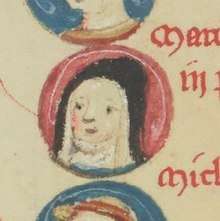Marie of Valois, Prioress of Poissy
Marie of France (24 August 1393 – 19 August 1438) was the daughter of Charles VI and his wife, Isabeau of Bavaria. She was a member of the House of Valois and became a nun.
| Marie of France | |
|---|---|
 | |
| Born | 24 August 1393 Bois de Vincennes, Paris |
| Died | 19 August 1438 (aged 44) Palais Royal, Paris |
| House | Valois |
| Father | Charles VI of France |
| Mother | Isabeau of Bavaria |
| Religion | Roman Catholic |
Life
Marie was born at the Bois de Vincennes and was the sixth of twelve children, eight of them including Marie lived to adulthood.
Marie's father was known to suffer from a hereditary mental illness. Isabeau had destined her daughter for the church, possibly because she saw her husband's madness as a punishment from God.[1]
Marie entered the convent of Poissy on 8 September 1397, taking her vows as a nun on 26 May 1408. She was the only one of the children that had a religious life; the rest of her surviving siblings were married off.
At the time Marie entered the convent the prioress was her great-aunt, Marie of Bourbon, who was the sister of the younger Marie's paternal grandmother, Joanna of Bourbon. Entering the convent with young Marie as a companion was another Marie, the daughter of Christine de Pizan. Christine described a visit to Poissy in 1400 in her work "Le Livre du Dit de Poissy,"[2] where she was greeted "joyously and tenderly" by the seven-year-old Marie of Valois and the Prioress. Christine also described Marie's lodgings as befitting a royal princess.[3]
In 1405, her mother, Isabeau, and her uncle, Louis I, Duke of Orléans, visited her and tried to convince her to abandon the religious life in order to marry Edward, son of Robert, Duke of Bar, an ally of Louis. But she declined, emphasising that only the king (who was mentally unstable at this time) had the power to force her to take a husband, and she remained at the abbey.[4] In later years, she became prioress of the convent and lived out the rest of her life there. She died of the Black Death on 19 August 1438 at the Palais Royal in Paris and is buried at the convent.[5] The only one of her siblings who survived her was King Charles VII.
Ancestry
| Ancestors of Marie of Valois | ||||||||||||||||||||||||||||||||||||||||||||||||||||||||||||||||||||||||||||||||||||||||||||||||||||||||||||||||||||||||||||||||||||||||||||||||||||||||||||||||||||||||||||||||||||||||||||||||||||||||||||||||||||||||||||||||||||||||||||||||||||||||||||||||||||||||||||||||||||||||||||||||||||||||||||||||||||||||||||||||||||||||||||||||||||||||||||||||||||||||||||||||||||||||||||||||||||||||||||||||||||||||||||||||||||||||||||||||||||||||||||||||||||||||||||||||||||||||||||||||||||||||||||||||||||||||||||||||||||||||||||||||||||||||||||||||||||||||||||||||||||||||||||||||||||||||||||||||
|---|---|---|---|---|---|---|---|---|---|---|---|---|---|---|---|---|---|---|---|---|---|---|---|---|---|---|---|---|---|---|---|---|---|---|---|---|---|---|---|---|---|---|---|---|---|---|---|---|---|---|---|---|---|---|---|---|---|---|---|---|---|---|---|---|---|---|---|---|---|---|---|---|---|---|---|---|---|---|---|---|---|---|---|---|---|---|---|---|---|---|---|---|---|---|---|---|---|---|---|---|---|---|---|---|---|---|---|---|---|---|---|---|---|---|---|---|---|---|---|---|---|---|---|---|---|---|---|---|---|---|---|---|---|---|---|---|---|---|---|---|---|---|---|---|---|---|---|---|---|---|---|---|---|---|---|---|---|---|---|---|---|---|---|---|---|---|---|---|---|---|---|---|---|---|---|---|---|---|---|---|---|---|---|---|---|---|---|---|---|---|---|---|---|---|---|---|---|---|---|---|---|---|---|---|---|---|---|---|---|---|---|---|---|---|---|---|---|---|---|---|---|---|---|---|---|---|---|---|---|---|---|---|---|---|---|---|---|---|---|---|---|---|---|---|---|---|---|---|---|---|---|---|---|---|---|---|---|---|---|---|---|---|---|---|---|---|---|---|---|---|---|---|---|---|---|---|---|---|---|---|---|---|---|---|---|---|---|---|---|---|---|---|---|---|---|---|---|---|---|---|---|---|---|---|---|---|---|---|---|---|---|---|---|---|---|---|---|---|---|---|---|---|---|---|---|---|---|---|---|---|---|---|---|---|---|---|---|---|---|---|---|---|---|---|---|---|---|---|---|---|---|---|---|---|---|---|---|---|---|---|---|---|---|---|---|---|---|---|---|---|---|---|---|---|---|---|---|---|---|---|---|---|---|---|---|---|---|---|---|---|---|---|---|---|---|---|---|---|---|---|---|---|---|---|---|---|---|---|---|---|---|---|---|---|---|---|---|---|---|---|---|---|---|---|---|---|---|---|---|---|---|---|---|---|---|---|---|---|---|---|---|---|---|---|---|---|---|---|---|---|---|---|---|---|---|---|---|---|---|---|---|---|---|---|---|---|---|---|---|---|---|---|---|---|---|---|---|---|---|---|---|---|---|---|---|---|---|---|---|---|---|---|---|---|---|---|---|---|---|---|---|---|---|---|---|---|---|---|---|---|---|---|---|---|---|---|---|---|---|---|---|---|---|---|---|---|---|---|---|---|---|---|---|---|---|---|---|---|---|---|---|---|---|---|---|---|---|---|---|---|---|---|---|---|---|---|---|---|---|---|---|---|---|---|---|---|---|---|---|---|---|---|---|---|---|---|---|---|---|---|---|---|---|---|---|---|---|---|---|---|---|---|
| ||||||||||||||||||||||||||||||||||||||||||||||||||||||||||||||||||||||||||||||||||||||||||||||||||||||||||||||||||||||||||||||||||||||||||||||||||||||||||||||||||||||||||||||||||||||||||||||||||||||||||||||||||||||||||||||||||||||||||||||||||||||||||||||||||||||||||||||||||||||||||||||||||||||||||||||||||||||||||||||||||||||||||||||||||||||||||||||||||||||||||||||||||||||||||||||||||||||||||||||||||||||||||||||||||||||||||||||||||||||||||||||||||||||||||||||||||||||||||||||||||||||||||||||||||||||||||||||||||||||||||||||||||||||||||||||||||||||||||||||||||||||||||||||||||||||||||||||||
References
- Kerrebrouck (Valois), p. 125 footnote 40, referring to Françoise Autrand "Charles VI le roi fou" in L'Histoire no 27 Oct 1980 pp 61-62.
- "Springtime, Solitude and Society in the Dit de Poissy".
- Power, Eileen Edna. Medieval English Nunneries.
- Jean Juvénal des Ursins (1851). Michaud and Poujoulat (ed.). Histoire de Charles VI, roy de France. Paris: Guyot Frères. p. 431.
- Cawley, Charles, Capet, Medieval Lands, Medieval Lands database, Foundation for Medieval Genealogy,